
Church Hill Historic District to be Added to the
State and National Register for Historic Places
State Historic Preservation Board Recommends 20 Nominations for State & National Registers of Historic Places Sites Represent Diverse Histories Including Church Hill Historic District in Saratoga County
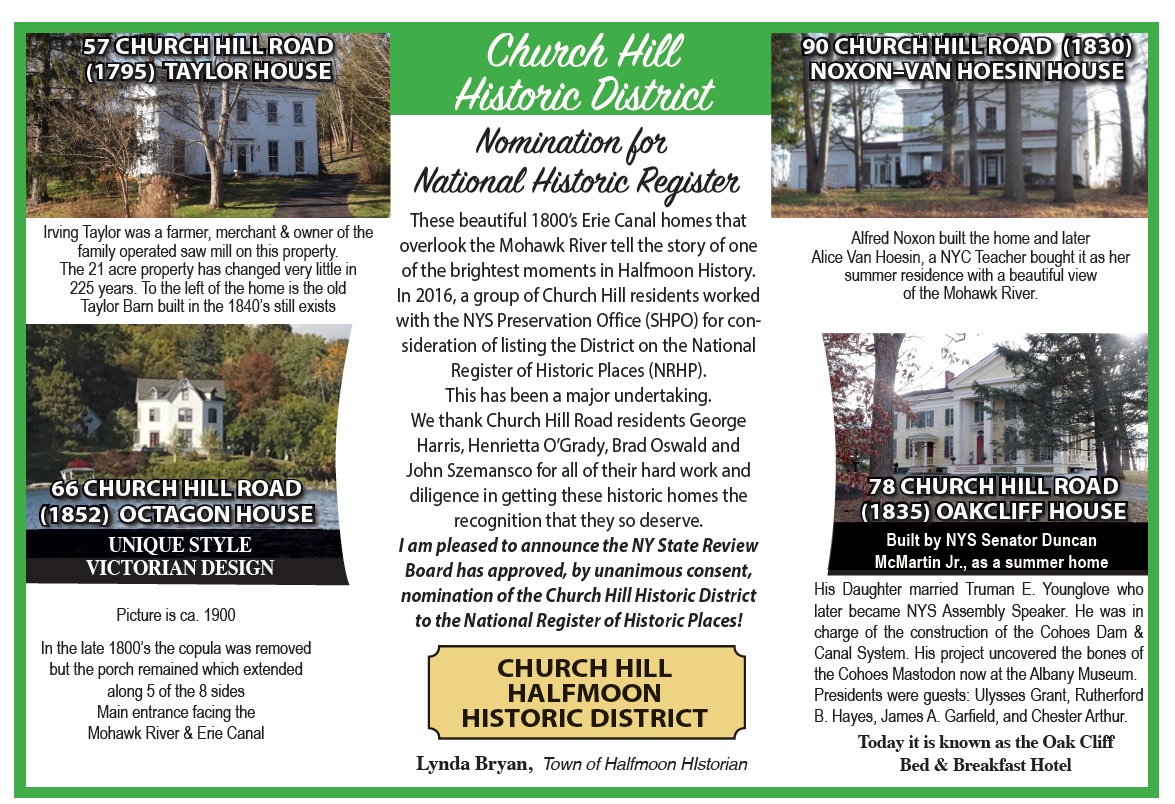
The Church Hill Historic District is in the hamlet of Crescent, Town of Halfmoon. The district reflects the heyday of the Erie Canal and includes 13 primarily residential structures dating from the 19th century. Sited on the north side of the Mohawk River, the district includes a remaining section of the Halfmoon Aqueduct, which once carried the Erie Canal across the Mohawk. During this period, the hamlet was a canal shipping point for ice, grain, hay, and molders’ sand produced in southern Saratoga County.
The Saratoga County History Center is pleased to congratulate the Church Hill Historic District, in the hamlet of Crescent in the Town of Halfmoon, on its nomination to be added to the State and National Register for Historic Places. The Church Hill Historic District will become the 11th historic district in Saratoga County.
“The Saratoga County History Center is excited to see the recognition of one of our county’s historic nineteenth century canal communities,” remarked Board President Jere Blackwelder. “Preservation and revitalization of these landmarks helps us ensure that future generations have access to our history and can see first-hand the legacy of Saratoga County. The district is in a beautiful section of Halfmoon along the Erie Canal.”
Lynda Bryan, Town of Halfmoon Historian, explains: “These beautiful 1800s Erie Canal homes that overlook the Mohawk River tell the story of one of the brightest moments in Halfmoon history. In 2016, a group of Church Hill residents worked with the NYS Preservation Office (SHPO) for consideration of listing the District. This has been a major undertaking. The community thanks Church Hill Road residents GeorgeHarris, Henrietta O’Grady, Brad Oswald and John Szemansco for all of their hard work and diligence in getting these historic homes the recognition that they so deserve.”
Saratoga County Historian Lauren Roberts adds, “The history and development of Saratoga County is intricately tied to one distinct, vital natural resource: water. From our County’s geographic location along both the Hudson and Mohawk Rivers, to the mineral springs which attracted a myriad of tourists to Saratoga Springs and Ballston Spa, to the prosperity afforded us by the construction of both the Champlain and Erie Canal, our county has relied upon water as the essence of our success. The Church Hill Historic District is certainly reflective of this concept.”
According to Russ VanDervoort, Waterford Town Historian and trustee of the Saratoga County History Center, “The nomination of the Church Hill District is a well-deserved honor of recognition for that canal community, especially in observance of the upcoming 200th-year mark of the Grand Canal.”
New York will be celebrating the 200th Anniversary of the iconic Erie Canal during a “bicentennial period” from 2017-2025, representing the span of construction of the canal, from the groundbreaking in Rome in 1817 to the fabled “Wedding of the Waters” in New York Harbor in 1825.
The Church Hill Historic District is in the hamlet of Crescent, just to the east of NYS Route 9, in Halfmoon, NY. The district includes thirteen residential structures, outstanding examples of how the Erie Canal and the Mohawk River shaped communities along the southern border of Saratoga County. A burst of prosperity in the second quarter of the 19th century related to the location of the Crescent Aqueduct was responsible for many of the architectural examples of high-style homes and businesses in this hamlet. Subsequently, the demise of the original canal and changing forms of transportation forced this community to evolve, first as a result of the Barge Canal and then as a result of increasing automobile traffic. Throughout these changes, stellar examples of both high-style buildings and vernacular structures remain to tell the story of the bygone canal era. They deserve the measures of protection that a listing on the register affords them.
“The nominations reflect the state’s commitment to supporting the incredible and sometimes overlooked history forged by the diverse people of New York,” said Erik Kulleseid, Commissioner of the Office of Parks, Recreation and Historic Preservation. “Securing recognition for such places will help to protect and preserve this history so that it can be carried safe and intact into the future.”
Over seventy-five Saratoga County districts, sites, buildings, and structures are listed on the National Register of Historic Places, the United States of America’s official list of historic properties worthy of preservation. Buildings that are listed on the State and National Registers are eligible for various public preservation programs and services — such as matching state grants, or state and federal historic rehabilitation tax credits — to assist property owners in maintaining and revitalizing the buildings.
“These latest nominations continue the Division for Historic Preservation’s (DHP) commitment to designating and supporting historic sites that represent the histories of our State’s diverse population,” said Daniel Mackay, Deputy Commissioner for Historic Preservation at State Parks.
The State and National Registers are the official lists of buildings, structures, districts, landscapes, objects, and sites significant in the history, architecture, archaeology and culture of New York State and the nation. There are more than 120,000 historic properties throughout the state listed on the National Register of Historic Places, individually or as components of historic districts. Property owners, municipalities, and organizations from communities throughout the state sponsored the nominations.
Once recommendations are approved by the Commissioner, who serves as the State Historic Preservation Officer, the properties are listed on the New York State Register of Historic Places and then nominated to the National Register of Historic Places, where they are reviewed and, once approved, entered on the National Register.
More information, with photos of the nominations, is available on the Office of Parks, Recreation and Historic Preservation website.
The Saratoga County History Center is dedicated to preserving and sharing the diverse histories of Saratoga County. Previously focused on the Brookside Museum in Ballston Spa, the SCHC now offers a wide variety of innovative, exciting, and education programming online.In particular, a town hall-style public forum on climate change and historic preservation is slated for the fall. When Brookside Museum re-opens this summer, the SCHC will debut new exhibits and family-friendly events. Please see the SCHC website (www.brooksidemuseum.org) and our social media accounts (@SaratogaCoHistory) for news and announcements.
Background Information –
State Historic Preservation Board Recommends 20 Nominations for State & National Registers of Historic Places https://parks.ny.gov/newsroom/press-releases/release.aspx?r=1636
Lynda Bryan, Town of Halfmoon Historianprovided thatsome of the properties include:
78 CHURCH HILL ROAD(1835) OAKCLIFF HOUSE NYS Senator Duncan
McMartin Jr., built the house as a summer home. His Daughter married Truman E. Younglove who later became NYS Assembly Speaker. He was in charge of the construction of the Cohoes Dam &Canal System. That project uncovered the bones of the Cohoes Mastodon now at the New York State Museum in Albany. Presidents Ulysses Grant, RutherfordB. Hayes, James A. Garfield, and Chester Arthur were guest at the house. Today it is known as the Oak Cliff
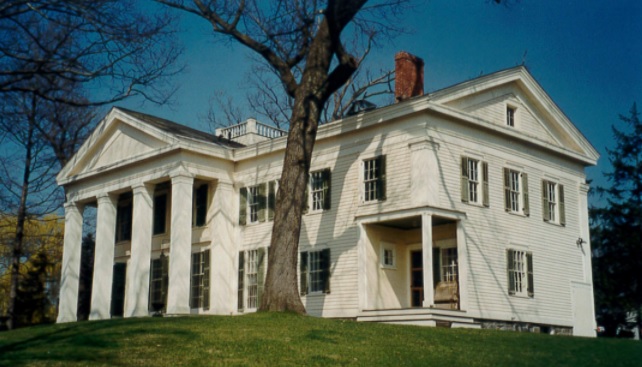
Bed & Breakfast Hotel, photo courtesy Halfmoon Historian’s Office
57 CHURCH HILL ROAD (1795) TAYLOR HOUSE – Irving Taylor was a farmer, merchant & owner of the family operated sawmill on this property. The 21-acre property has changed very little in 225 years. To the left of the home is the old Taylor Barn built in the 1840’s still exists
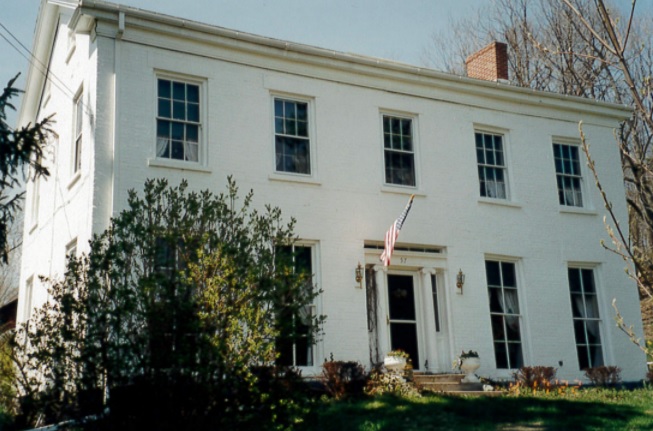
Photo courtesy Halfmoon Historian’s Office
66 CHURCH HILL ROAD (1852) OCTAGON HOUSE – In the late 1800’s the copula was removed but the porch remained which extended along 5 of the 8 sides. The main entrance faces the Mohawk River & Erie Canal.
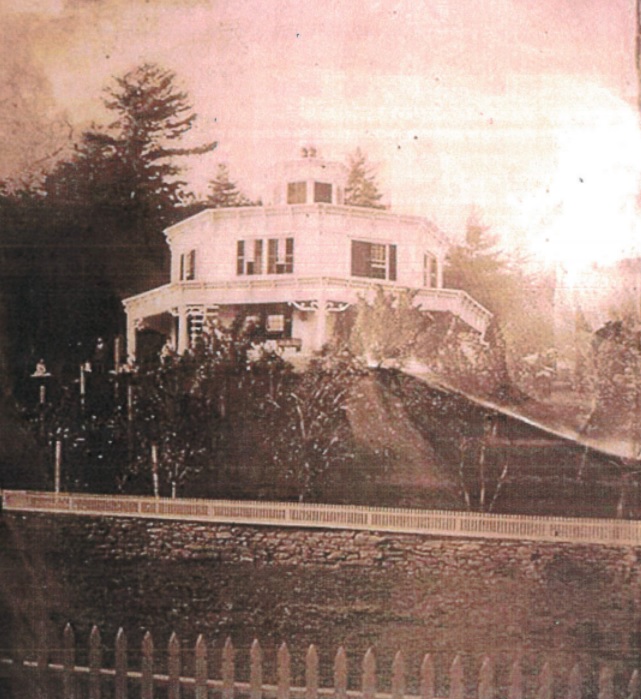
The photo is from the 1870s before the copula was removed. Photo courtesy Halfmoon Historian’s Office
90 CHURCH HILL ROAD (1830) NOXON–VAN HOESIN HOUSE – Alfred Noxon built the home and later Alice Van Hoesin, a NYC Teacher bought it as her summer residence with a beautiful view of the Mohawk River.
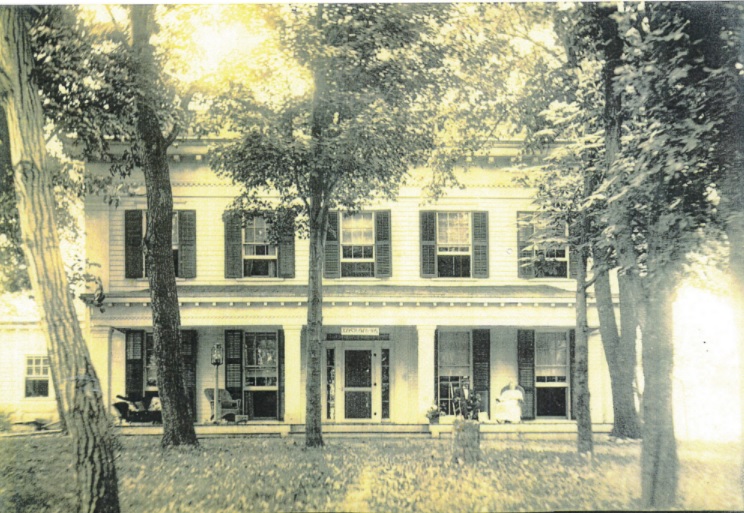
The photo is from the early 1900s. Photo courtesy Halfmoon Historian’s Office
Items in the Saratoga County History Center focused on the hamlet of Crescent can be found at
Items in the Saratoga County History Center focused on the hamlet of Crescent can be found at
For inquiries, please contact Sean Kelleher, Trustee, at historiantosaratoga@gmail.com.
Saratoga County History Center, 6 Charlton Street, Ballston Spa, NY 12020. Phone: 518-885-4000
















